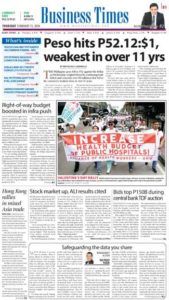MANILA: ECONOMY – Peso hits P52.12:$1, weakest in over 11 yrs | Thursday, February 15, 2018

The Philippine peso fell to P52 against the dollar on Wednesday, weighed down by a widening trade deficit and concerns over US inflation that led to the currency’s weakest close in over 11 years.
The local currency opened at P52.03:$1, traded at P51.90 to P52.12, and finally ended the day at P52.12 per dollar, 14 centavos weaker than Tuesday’s P51.98:$1 close.
The last time the local unit breached P52:$1 territory was 11 years ago or on July 21, 2006 when the peso closed at P52.16 to a dollar.
News that the country’s trade deficit had ballooned to $4.02 billion in December, leading to a full-year gap of $29.8 billion, was said to be a primary factor behind the peso’ decline to P51.79:$1 last Friday.
Worries that the trade deficit would further widen in 2018 were cited as prompting Monday’s fall, which analysts also attributed to corporate demand for the greenback.
With the US set to release latest inflation data, analysts said markets were waiting for clues as to how fast the Federal Reserve would proceed with its policy tightening.
“The exchange rate breached the P52:$1 mark still because of US rate hike expectations,” Land Bank of the Philippines market economist Guian Angelo Dumalagan said.
He noted that US Fed officials were generally in agreement on the need for additional rate hikes this year.
“Bets of firm US inflation data … and weaker-than-expected GDP [gross domestic product]growth from Japan likely contributed as well to the peso’s weakness,” Dumalagan said.
.
NOTE : All photographs, news, editorials, opinions, information, data, others have been taken from the Internet ..aseanews.net | [email protected] |
For comments, Email to :
Pahulu Gan – Contributor | [email protected]









